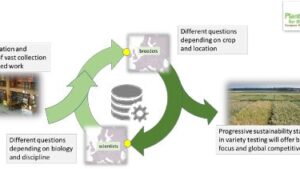The regulatory landscape for genome editing remains frustratingly cyclical, despite a decade of effort to clarify policies worldwide, according to Ray Dobert, consultant with Harambe Agriculture Consulting LLC.
Speaking at the 2025 ASTA Vegetable and Flower Seed Conference, Dobert compared the situation to a time loop, where progress is made but key challenges persist.
“Sometimes it feels like we’re in that same kind of a Groundhog Day kind of environment,” Dobert said. “So I just wanted to start off to sort of recognize that we’re not there. But you’ll see some similarities. And as I walk through sort of the landscape of what’s happening in the regulatory space around genome editing or plant breeding innovation, you’ll see that we’ve made quite a bit of progress, but there are some aspects that we do definitely feel like we’re stuck in neutral.”
Progress in Policy, But Uneven Adoption
Dobert explained that while many countries have developed genome editing policies over the last 10 years, global regulatory approaches remain inconsistent.
“We are entering the second decade, actually, of significant efforts around regulatory policy development related to genome editing,” he said. “Back in late 2015, the International Seed Federation came out with its policy statement that then essentially gave guidance to many world areas with regard to what should be the advocacy goal of the seed industry around plant breeding innovation. And it was pretty simply stated that the underlying principle was that like products should be treated similarly.”
This principle, he noted, was meant to ensure that crops developed with genome editing would not face stricter regulations than those bred conventionally, provided they are genetically and phenotypically similar.
Despite progress, some governments continue to treat genome-edited crops the same as GMOs, requiring lengthy and costly regulatory approvals.
“That very, very high hurdle has sort of kept the use of GMO technology, or transgenic technology, to just a few major commodity crops, with a few exceptions,” Dobert said. “But generally, it’s been the domain of those large commodity crops that are grown on significant acres, which can then be supporting the significant development costs, which can exceed well in excess of $200 million.”
Europe: The Global Bellwether for Genome Editing
While many regions are advancing clear policies, Europe remains a major obstacle for international genome editing adoption.
“I’ll talk a little bit about where we stand with Europe, which is kind of almost a bellwether with regard to how things go from a global perspective,” Dobert said.
The European Union has been debating changes to its strict GMO regulations, but progress is slow.
“There’s been quite a bit of work, quite a bit of activity over the past couple years in the EU,” he noted. “They are moving slowly again. We hope that 2025 is a year of great progress.”
Even if Europe finalizes its policy this year, he warned that implementation could take years.
“It will take probably several years before we actually have a system up in place with guidelines and final regulations in place before they’re open for business,” he said.
U.S. Policy: A Step Forward, Then a Step Back
Regulatory challenges exist in the United States as well. In December 2024, a federal court vacated USDA’s 2020 regulations, forcing a return to older regulatory frameworks.
“This is definitely a situation where it is Groundhog Day. We are back in late 2019 at USDA,” Dobert said.
The court ruling did not reverse prior approvals, meaning genome-edited products that had already cleared regulations remain unaffected. However, developers must now navigate an older, more cumbersome process to seek exemption from GMO oversight.
“They have taken quick action to sort of the field trial process. They used to have a notification to simplify process. Those are back up and running as of this week,” he said.
Meanwhile, the FDA has launched a pre-market meeting process to improve transparency but has not made participation mandatory.
“FDA basically says they just really want to be informed of what’s coming to the market,” Dobert explained.
At the EPA, policymakers are still debating the scope of oversight for genome-edited crops, particularly those involving plant-incorporated protectants or growth modifications.
“There’s a lot of activities even happening at the legislative level to try and have EPA scale back,” he said.
Innovation Stalled by Red Tape
Despite a decade of regulatory work, very few genome-edited crops have actually reached the market.
“The path to market remains very complex,” Dobert said. “Even though we’ve had all of those regulatory decisions, we have very, very few products globally that are gene-edited in the market. I mean literally, there’s a single product which currently is still in the market, and that is the editing tomato plant in Japan.”
That doesn’t mean progress has completely stalled.
“That does not mean that we should lose hope. There are a lot of products in the pipeline that are coming. I would say that in the next couple of years, you will see significant numbers of products coming to the marketplace,” Dobert said.
Still, developers face significant barriers beyond regulation.
“There are both, in addition to the GMO regulations, there’s bit of phytosanitary and other trade regulations that must be dealt with. There’s a ton of product logistics. I mean, the ability to produce product is not simple,” he said. “Again, this industry and folks in this room know that very well. The ability to move material across borders, import, export concerns, becomes significant, especially as you scale up.”
Looking Ahead
Dobert ended his talk with a call for continued industry engagement, urging companies and policymakers to push for science-based regulations that encourage innovation rather than restrict it.
“Hopefully, we don’t keep just spinning our wheels, and even in much less than 10 years from now, we start talking about a vast number of products that are actually in the marketplace,” he said.












